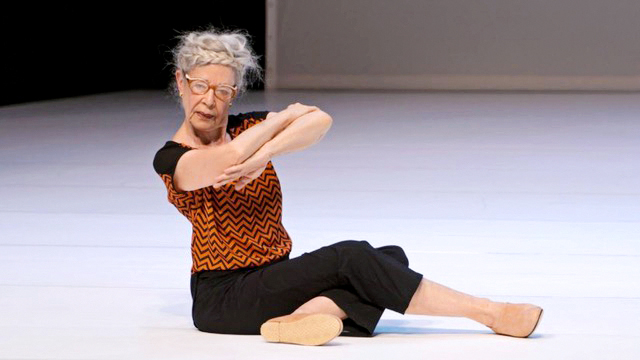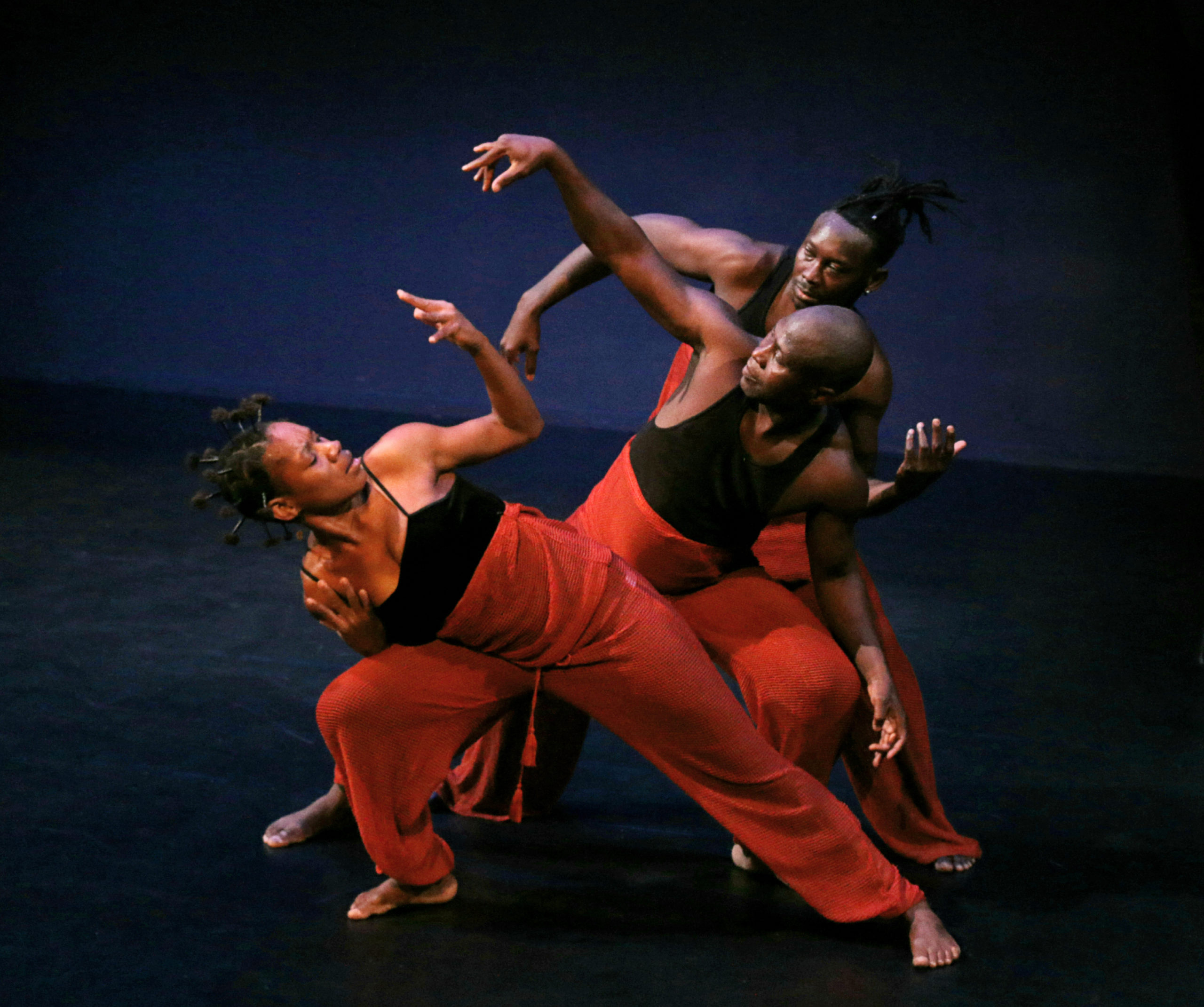3 Dancers Break Down Their Inner Monologues When They Perform
Whether at the beginning of a warm-up, deep in rehearsal or onstage, dancers have many thoughts racing through their minds at any given moment. The mental ticker tape covers anything from remembering choreographic sequences to navigating environmental factors, like uneven floor surfaces or bright lights, or evading pesky distractions. This is all in play at the same time that dancers are focused on artistic elements like building an energetic arc or adhering to a task-driven score. And yet, dancing is an act of immediate presence, action and expression. When dancers are onstage, thoughts that were previously in the form of words often sublimate into in-the-moment sensations.
Postmodern pioneer Deborah Hay has spent much of her six-decade career exploring the interplay between embodiment and consciousness onstage. In her seminal book My Body, The Buddhist, she writes: “I was inspired to construct a verbal dance vocabulary that merged personal and universal images. I wanted it to include the sensual experiences of perception. With the help of language, I wanted to simplify access to dancing, while expanding the territory from which a dancer could draw immediate kinesthetic experience.”

So what do dancers think about while dancing? What do their thoughts reveal about the artistic experience? Here, three veteran artists from across the globe share their inner monologues. Juxtaposed with excerpts from Hay’s existing practice-as-research, they offer intriguing glimpses of the rich, generative interplay between a dancer’s mind and body.
Etienne Cakpo
“She likes to juggle. Instead of balls or batons, she practices with four or five perceptual experiences at once.” Deborah Hay
Dancer and choreographer Etienne Cakpo, originally from Benin and now based in Seattle, where he directs Gansango Music & Dance, says that when he dances his own choreography, which draws from traditional spiritual, historical and social dances and also contemporary African dances, “I feel it all, the words, the visualizations, the sensations. It just comes when it comes!” His movements translate imagery from the natural world, like birds and animals, into human form. “See how powerful birds are when they take off, fly and land,” Cakpo says. “Their legs are always bent, ready. Watch how their feet grab the earth. The initiations for the full-bodied undulations in my choreography start in the feet for this reason.”
Cakpo also hears the guidance of an influential teacher who once said, “Listen to your breathing, listen to your heartbeat. If you hear this, you can hear the music.” He relates to the music for tempo, saying “when the drummer plays, my whole body engages. There’s no ‘going out and coming back’ to the tempo set by the drummer. The dancer and drummer are one together.”
Cakpo takes great inspiration from traditional dances from southern Benin, during some of which dancers are possessed by the Holy Spirit. “When in a trance, they can dance for two days straight in ceremonies. When they finish and come back into themselves, they remember nothing afterwards!” Contemporary African dance practices modernize movements from those traditions, he says, “but without the spiritual possession, as a way of promoting culture.” He works from an organic, improvisational place where his highest priority is something larger than himself. Cakpo says, “I’m always a messenger. When I’m performing and I feel the presence of the Holy Spirit, I offer respect, connection and love. Onstage, where I’m home in the place I feel safe, sometimes I want to cry for feeling so open.”
Kanoe Miller
“Praying became a dialogue with all there is.” Deborah Hay
A performer at the House Without A Key bar at the Halekulani Hotel in Honolulu for nearly 45 years, Kanoelehua “Kanoe” Miller describes her foundational training in hula, which she began as a young teenager, as an all-encompassing experience. “There is no ‘class card’ to purchase individual classes. A hālau (a traditional hula school) is a commitment for life. You delve into culture, dance steps and technique, historical dress, Hawaiian language that was purely oral until 1820, the way of thought before Westerners arrived with written language, music and the composer’s intent, which may have deeper layers of meaning than the literal words.”
In performance, hula dancers synthesize these layers of acquired knowledge and thought systems with their personal experiences in life and spirit. “Your brain is listening to the lyrics. Your heart is listening to the music,” Miller says. “You want to have a conversation with the audience. You express to them what you mean. You must internalize, correlate, and then you bring it out in your dance and in your face. It comes out of your pores.”

Like a Broadway performer who might execute the same role many nights per week for years on end, Miller has learned how to keep her performances fresh, mentally and physically, every night. “I love people. I want them to be lifted, to walk out three feet above the ground, to feel aloha. In the first part of my evening, it’s sunset. I can see everyone. For the second part, it’s dark. I can’t see faces and I have to work harder to connect. I dance into the light. It might not have been until I was in my 40s, though, that I really learned to concentrate and be in the zone, and to respect my audience. I go in every single night wanting to give aloha.”
“Do I hear my teachers’ voices? Sure,” Miller says. In addition to her background in hula, as an adult, she studied tap and jazz intensely, and this year she began studying ballet on Zoom. “I love the discipline of the presentation, engagement of the core, articulation of the feet and postural stances of these other forms. I incorporate it all. People don’t know why I look different from other performers. This is why.”
Megumi Eda
“My body seeks more than one view of itself.” Deborah Hay
An ever-evolving artist whose career has spanned multiple genres, Berlin-based Megumi Eda spent her childhood in Japan focused on classical ballet and went on to dance for several major European companies. “Ballet is so difficult,” she says. “I wanted to be perfect, I wanted the technique, but I was so worried about it that it was hard to express anything else. When I was a pure ballerina, I knew somehow it wasn’t for me. For others, maybe, but not for me.”
While working at Dutch National Ballet in her early 20s, Eda discovered that she preferred the excitement of creating new work with choreographers over dancing the classics. Even before moving to London in 2001 to dance with Rambert Dance Company and then shortly thereafter transitioning to New York City to work with Armitage Gone! Dance, she began to notice new internal shifts away from the perfectionism of her youth and into a more contemporary sensibility. “When I’m onstage, that’s when I think ‘I’m finally the boss!’ I create with a bigger imagination, with a system of images that I invented for myself, that I use onstage,” Eda says. “Every time I dance, I see something, like a nostalgic scene from my hometown or memories of intimate interactions. I see my grandmother. She’s passed on already. I hear her voice, I see her. She appears a lot.” In her postmodern dance work, Eda says she focuses more on shapes than emotions or technique, noting, “When I move in space, the shape of space changes. Even with a super-small flick of the finger, the space around that shifts.”

While Eda speaks several languages, she says the specificities of the separate languages don’t play a big part in her process, the scope of which has widened to include work as an accomplished filmmaker, video editor and director. Instead, she says her practice is rooted in the idea of “continually translating” her overarching interests into movement and film. “I share on the screen what I’ve always seen in my head when I’m dancing. I use film to show the secrets in my mind.”





